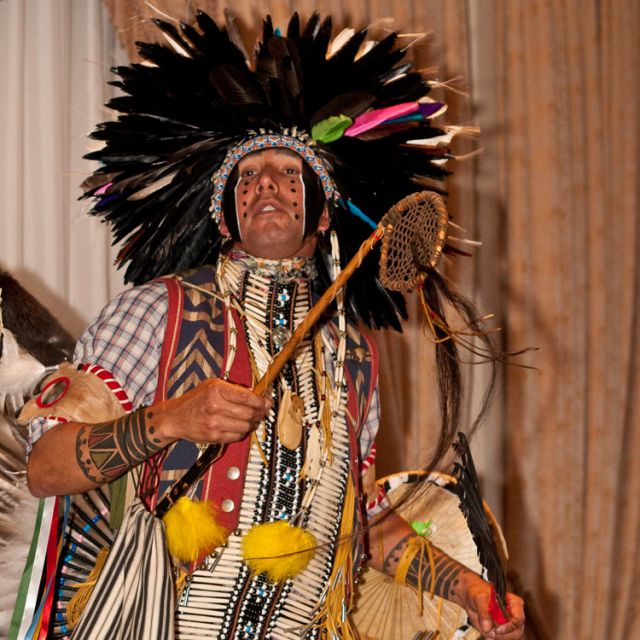The TRC's visit to Toronto is a matter of life and death for Native culture said event organizer Darlene Ritchie.
"Our people are on the edge. Our people are facing extinction," said Ritchie, the president of Toronto Council Fire Native Cultural Centre.
As Native languages, spirituality and customs disappear under economic and cultural pressure it's essential for the first of Canada's three founding nations to tell its story of survival to the rest of the country, said Ritchie. Coming to the heart of Canada's media, financial and cultural industries to present the oral history of residential schools is a matter of claiming equal status in Canada, she said.
"We really don't have a choice," Ritchie said. "We either stand up and claim it for ourselves or we go over the edge."
The Toronto event is an attempt to engage the majority of Canadians, said TRC commissioner Marie Wilson. While 75 per cent of aboriginal Canadians live north and west of Winnipeg, 75 per cent of Canadians live in the cities and towns east of Winnipeg. Trying to bring these separate worlds together is a first step toward reconciliation, said Wilson.
"How do we engage the other 35 million people in this country who are not indigenous, who think this has nothing to do with them?" Wilson asked.
The Commission's aim is to introduce to majority to Canada's real history as a colonizing nation, Wilson said.
"We don't get to cherry pick our history," she said.
In particular the message has to get out to the new Canadians who make up a slight majority in Toronto, said Wilson.
"It's important for newcomers and all Canadians to acknowledge what this land is," said Ritchie.
Part of Canada's history that most Canadians still don't know is the role Chief Tecumseh played in ensuring Canada survived the War of 1812, Ritchie said. Without Tecumseh's Confederacy, the British could not have won the war.
"We won the War of 1812," said an emotional Ritchie. "And what did we get as thanks? As acknowledgment? We got the Indian Act of 1829."
The event opened Thursday evening with displays of native art, craft, music and dance. Lieutenant Governor David Onley brought greetings from the crown.
"In the name of Her Majesty the Queen, who in living form represents all the documents ever signed, I pledge to continue the journey with you," Onley told a packed ballroom at the Sheraton Centre Hotel.
It's ironic that Canadians take pride in their historic role opposing apartheid in South Africa but don't know their own history in relation to the original people of their country, Onley said.
"We too have a crying need for truth," he said.
Getting things right between Native people and the Canadian majority is not a matter of rebuilding a broken relationship but of building a new relationship built on trust, said Ontario Aboriginal Affairs Minister Kathleen Wynne.
"It's not that we can go back to something. It's that we must build something going forward," said Wynne.
The four Churches that ran residential schools (about 60 per cent of them were Catholic, 30 per cent Anglican and the remainder United or Presbyterian) have representatives at The Meeting Place. The Church representatives are there to listen to survivor stories and offer words of reconciliation.
About 150,000 aboriginal children were placed in residential schools between 1870 and 1990. For most of their history the schools were designed to assimilate the children into white society by erasing their language and spiritual customs and equipping them with trades and farming skills.
TRC Commission brings Native issues to heart of Toronto
By Michael Swan, The Catholic RegisterThe bitter history of Canada's attempt to wipe out aboriginal culture through a system of Church-run schools has come to Canada's largest and most invisible Native community — and it's biggest city.
The Truth and Reconciliation Commission of Canada is meeting with 600 delegates, including about 100 residential school survivors, in downtown Toronto at a May 31 to June 2 community-organized event called The Meeting Place, a name that freely translates the Mohawk word ktaronto, which eventually became the name of the city. There are about 80,000 aboriginal Canadians — Metis, Indian and Inuit — living in Toronto.
Please support The Catholic Register
Unlike many media companies, The Catholic Register has never charged readers for access to the news and information on our website. We want to keep our award-winning journalism as widely available as possible. But we need your help.
For more than 125 years, The Register has been a trusted source of faith-based journalism. By making even a small donation you help ensure our future as an important voice in the Catholic Church. If you support the mission of Catholic journalism, please donate today. Thank you.
DONATE
